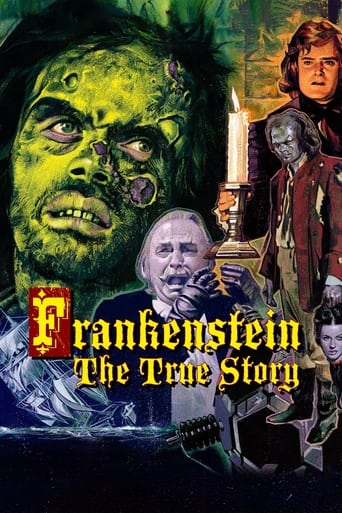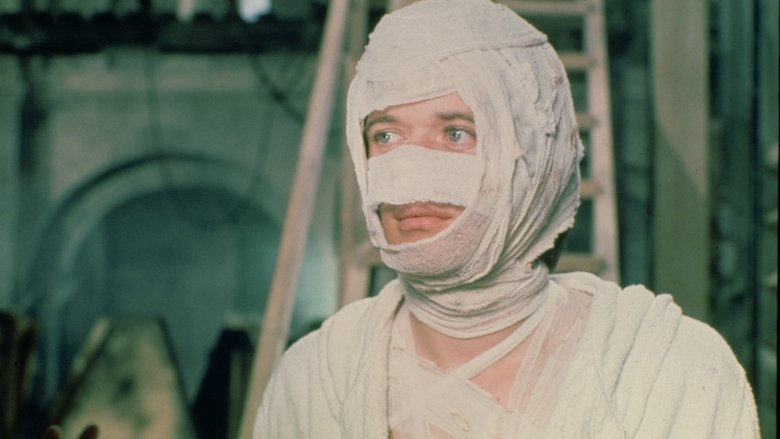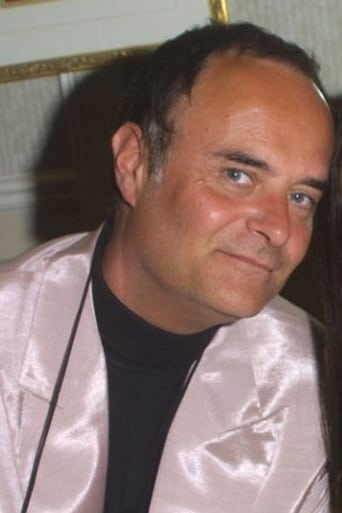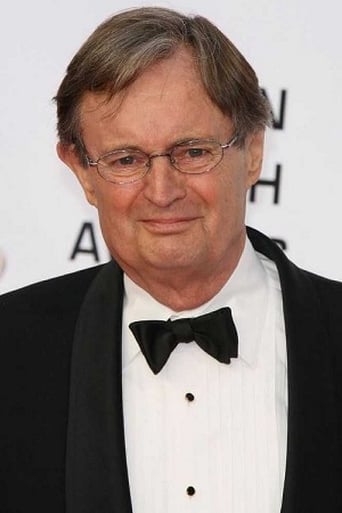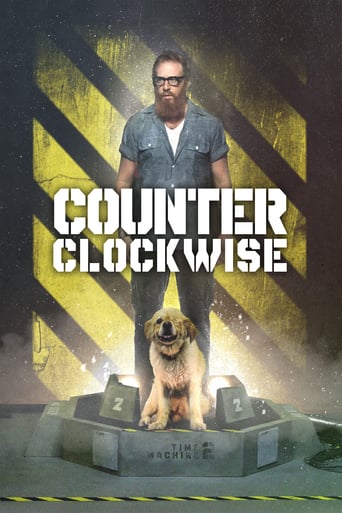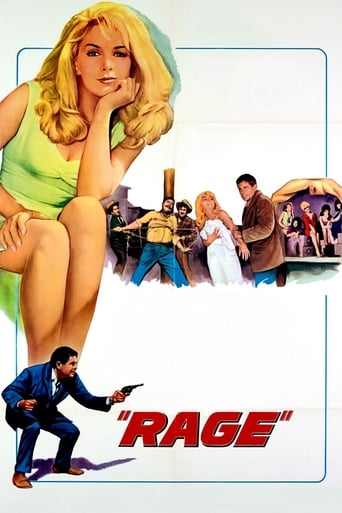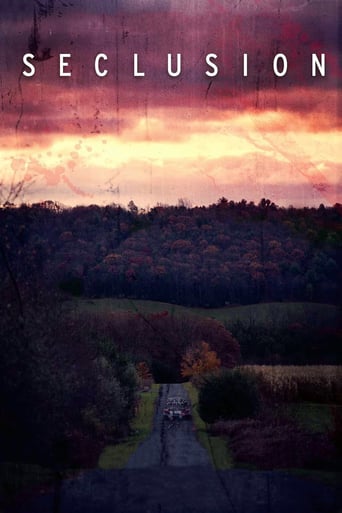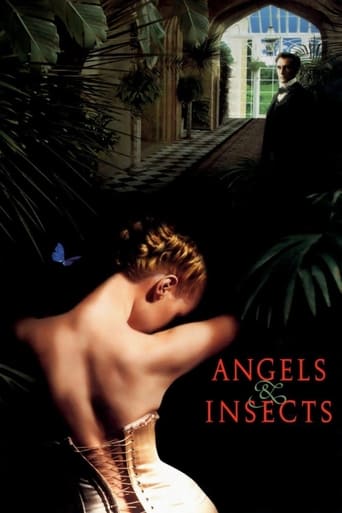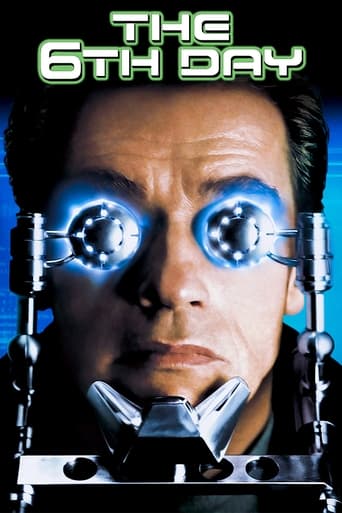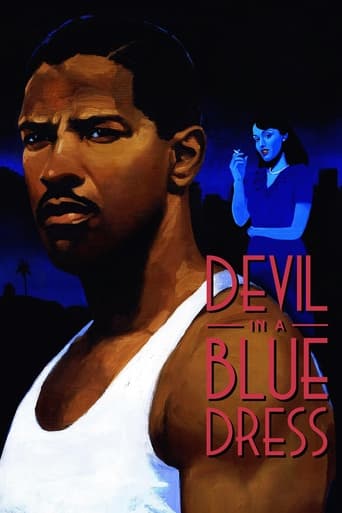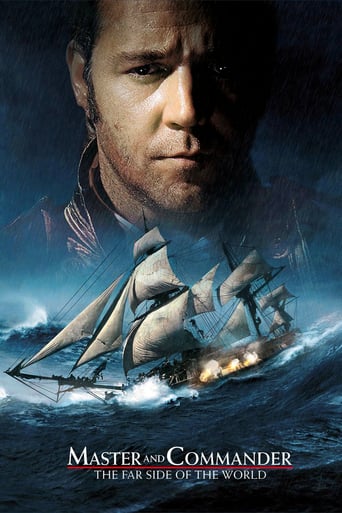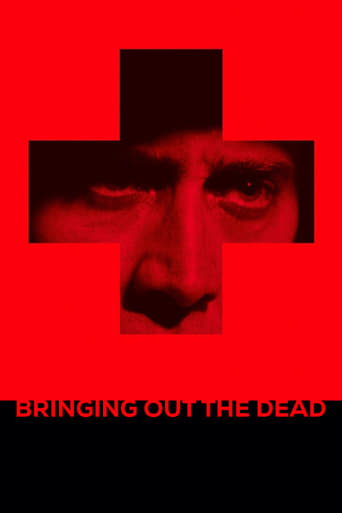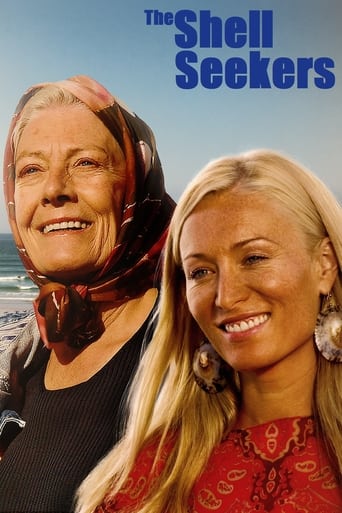Frankenstein: The True Story (1974)
Victor Frankenstein witnesses his creation turn uncontrollable after he's duped by his associate, Dr. Polidori.
Watch Trailer
Cast
Similar titles
Reviews
A brilliant film that helped define a genre
A lot of perfectly good film show their cards early, establish a unique premise and let the audience explore a topic at a leisurely pace, without much in terms of surprise. this film is not one of those films.
Great example of an old-fashioned, pure-at-heart escapist event movie that doesn't pretend to be anything that it's not and has boat loads of fun being its own ludicrous self.
This is one of the best movies I’ve seen in a very long time. You have to go and see this on the big screen.
I must add my own two-cents worth to those others who regard Frankenstein: The True Story as the most satisfying film version of of Mary Shelly's 1818 classic. Though it is not a literal translation of the story, it captures the philosophical nature, melancholy mood and epic scope of Mrs. Shelly's novel better than any other celluloid rendition. While keeping the bare bones (no pun intended) of the novel's plot, it dances all around the original story, pulling off plot elements here and there, then sticking them back on elsewhere. For instance, Henri, in the original merely Victor Frankenstein's concerned best friend, is transformed into a mad doctor who gives Victor the monster-making knowledge. In the book Elizabeth was the ward of Victor's father, but Vic is the ward of Liz's dad in True Story. The Dr. Polidori character, played by James Mason oozing evil from every pore, was a brilliant touch, but no such character appears in the novel. Yet, there was a real-life Polidori in Mary Shelly's orbit. He was Shelly friend Lord Byron's personal physician, confidant, and dope supplier. A brilliant young man, who had already published several medical books, he tragically took his own life at age 21 -- according to some, because of his unrequited love for Mary Shelly!True Story owes little to previous movie versions, neither the mossy old 1930's and 'forties Universal Frankenstein series or Hammer's 1950's/'60's revivals, but is a completely fresh approach. The brilliant script by Isherwood and Bachardy is almost as literary as Mrs. Shelly novel, yet even more exciting and stimulating. True Story is a splendid production, probably one of the most handsomely turned out made-for-TV numbers of all time. Period (1797 and following) sets and costumes are exquisite. The cinematography is beautiful, belying its TV origins every step of the way. Unlike most TV movies of the time and practically all current theatrical movies, it disdains the shot-a-second montage method in favor of the mise-en-scene approach -- every scene starts with a precisely composed long shot, which gradually pans in to close-up. This classic style of cinematography complements the beautiful sets, enhances the melancholy mood, and displays the humanity of the characters better than montage. Here it is used brilliantly by director of photography Arthur Ibbetson and director Jack Smight.Frankenstein: The True Story is expertly acted by Mason, Leonard Whiting (Victor), Nicole Padget (Elizabeth), Michael Sarrizan (Creature), Jane Seymour (female creature) and the rest of a fine cast. It is dramatically engaging, thoroughly engrossing for its entire three hours, intellectually stimulating, and gorgeously filmed. A delight from beginning to end. Even Old Hollywood would have been proud to have turned out such a complete motion picture.P.S. -- Those who are interested in learning more about that early 19th century femme fa-tale and the origin of her famous monster story would do well to read Miranda Seymour's superbly researched, highly readable biography of Mary Shelly (Grove Press, NY, 2000).
Every film version of FRANKENSTEIN has taken tremendous liberties with Mary Shelly's celebrated 1818 novel, and although it retains the core idea of the book this one is no exception. Produced for television by Universal Studios in 1973, the film contains a host of characters and ideas that draw more from previous film versions than from the original novel. More interestingly, however, it introduces a number of distinctly original concepts as well.Simply stated, the film has a highly disconcerting and surprisingly overt homo-erotic edge. Instead of the inevitable "mad doctor" typical of films, Victor Frankestein is a remarkably handsome young man in the form of actor Leonard Whiting, a performer best known as Romeo in the famous 1968 ROMEO AND JULIET. He is seduced into the experiment by the equally handsome but distinctly odd Henry Clerval (David McCallum)--and not only do the two actors play the relationship in a disquietingly touchy-feely way, Clerval takes exception to Victor's fiancée Elizabeth (Nicola Pagett) and she returns the favor, demanding that Victor choose between them.Lest any one miss the implications, the creature is played by none other than Michael Sarrazin, and while many men may be described as handsome, Sarrazin is among the few who can be justly described as beautiful. He arises from the laboratory table barely decent in a few strategically placed bandages, and when his facial covering is pulled aside by the eager Dr. Frankenstein we are treated to a lingering image of glossy black hair, pale complexion, remarkably liquid eyes, and lips that would make Vogue model weep with envy. Dr. Frankenstein takes him to his own apartment, where he educates this child-like innocent and very generously allows the creature to sleep in his own bed.But, as in all FRANKENSTEIN movies, the experiment goes awry, and when it does the same disconcerting homo-erotic overtones take yet another turn. Due to some unknown error in the creation process, the creature begins to deteriorate in appearance--and instead of continuing to treat him kindly, Frankenstein keeps the creature locked up, becomes verbally abusive to him, and no longer allows the creature to sleep in his bed, relegating him to a cramped mattress on the floor. At the same time, Frankenstein is approached by the mysterious Dr. Polidori (the legendary James Mason), an oily scientist with a flair for hypnosis who claims to know what went wrong.Polidori insists that they abandon the creature and create a new one: a woman, and when this new creation emerges from an entirely different process she too is remarkably beautiful; indeed, she is none other than Jane Seymour. But whereas the original creature was a gentle creature who only learned violence from Frankenstein's hateful rejection, this new entity is strangely icy, almost snake-like from the very beginning--and the male creature, now both vicious and wildly jealous, will exact a horrific toll upon all concerned.It is worth pointing out that the script for this version of FRANKENSTEIN was co-authored by Christopher Isherwood (1904-1986), one of the few openly gay writers of his era. Sexuality in general and homosexuality in particular forms a theme in many of Isherwood's works, so it would seem reasonable to assume that he was responsible for the homo-erotic elements of the film. Jack Smight's direction does not offer anything nearly so interesting as the script, but it is workman-like, and while the production values tend to be a shade too baroque for their own good one never lacks for something to look at on the screen.The cast is also quite good. At the time, the film was looked upon as a "television event," and it drew a host of noted actors, including John Gielgud and Agnes Moorehead. No one would accuse Leonard Whiting of being a great screen talent, but he acquits himself very well; so too does David McCallum, Nicola Pagett, and the always memorable James Mason. But the real knock-out performances here are by Sarrazin and Seymour, who truly blow the lid off our ideas of what a FRANKENSTEIN movie should be--and when they square off the result is unsettling in a truly unexpected way. In terms of the DVD itself, the film quality is considerably better than the rare late-night showings I've occasionally seen on television, but I would not describe it as pristine, and I found I frequently had to bump up the volume on the soundtrack.If you are looking for something with which to scare yourself silly, you might want to give this version FRANKENSTEIN a miss; although it has a few visceral moments, the jolts involved are largely psycho-sexual. But if you are open to the sexually subversive, which is particularly unexpected in a made-for-television film from 1973, you couldn't make a better choice. Recommended.GFT, Amazon Reviewer
I had always wanted to watch this after reading about it in Alan Frank's book "Horror Films", but missed out on it on Italian TV as a kid. When it was announced for DVD release, I pre-ordered it (despite being a bare-bones affair) but, after reading the first negative review - via DVD Talk, as there was mention of poor video quality and even edited footage - I almost cancelled it outright! However, having watched it myself, I found no complaints with the former and, being a first viewing, I had no opinion about the latter - to be honest, Frank's description of The Creature ripping out Prima's head from her body had fired up my imagination all these many years, and found the scene as is in the film something of a let-down, but I couldn't verily say if it was trimmed or not; likewise, I felt that the opening sequence (the drowning of Frankenstein's younger brother) was too abrupt, i.e. without having taken the time to create a genuine rapport between the two (which would have made Victor's subsequent obsession with bringing the dead back to life that much more purposeful!)...but, again, I don't know if it has always been this way or if it originally ran longer!! The prologue was a mistake, in my opinion, as it feels awkward - like a Theatrical Trailer attached to the beginning of a movie, complete with spoilers galore! Obviously, I've watched countless adaptations of the Mary Shelley classic along the years - and it's always interesting to see the way in which the original text is 're-invented' by the various writers and film-makers; this epic, star-studded production is certainly among the most intelligent, literate renditions (co-scripted by Christopher Isherwood) although, to be honest, I found it most compelling during the first hour or so; maybe that's because I was used to seeing a hulking, misunderstood creature rather than the dapper and relatively inconspicuous one depicted here! Besides, David MacCallum's contribution is so strong (I had seen him in a few films and TV shows, but nothing as impressive as this!) during these initial stages that when his character is killed off, immediately prior to the first creation scene, it never fully recovers!! Still, James Mason's Dr. Polidori makes for a great villain in the Praetorius tradition (though nothing so campy as Ernest Thesiger); in fact, even if the character is somewhat overwritten (coming off as a power-mad evil genius more akin to Fu Manchu than anything else, flanked by a couple of Asian henchmen no less!), Mason's playing is generally understated throughout - yet effortlessly dominating every scene he's in. Leonard Whiting isn't bad as Frankenstein, simply too youthful for the role - displaying none of the intensity of Colin Clive or the fastidiousness of Peter Cushing. Michael Sarrazin, as I said before, makes for a rather unalarming creature - though his subsequent physical and mental deterioration provides some undeniably effective moments (such as in the afore-mentioned scene with Prima, the unsuccessful attempt by Polidori and Frankenstein to destroy him, and the doomed sea voyage at the finale); that said, it appears that the conception itself of The Creature has problems: at first, MacCallum's Henry Clerval complains that he has been saddled with a peasant's brain for his creation and, yet when Frankenstein eventually substitutes it with that of Clerval himself, Sarrazin still emerges an illiterate - until the very end when he unaccountably starts reasoning the way Clerval would have and is even able to guide the ship to the Arctic (it somehow doesn't feel right that Prima receives schooling whereas The Creature does not, or rather learns precious little from his various misadventures, such as the encounter with the blind hermit or his sojourn with Polidori - when both these incidents, as depicted in BRIDE OF FRANKENSTEIN [1935], had proved crucial to The Creature's formation of character)! One of the most satisfying aspects to the film is the unusually strong participation of the female leads, both of whom add effortless grace to the proceedings but also deliver fine performances: Nicola Pagett is certainly the most significant Elizabeth I have seen, while Jane Seymour appears in a 'dual' role as the blind hermit's grand-daughter and the mischievous, sexy Prima (The Creature's female counterpart whom Dr. Polidori proposes to integrate into affluent London society, for his own sinister ends, with disastrous consequences). The supporting cast is chosen with an eye to adding further distinction to the production if little else, as none of the various thespians are particularly taxed by the brief roles they have been offered! The film was made by Universal, interestingly enough, but shooting took place in London (to where the story itself is, bafflingly, re-set for the most part!). Even if director Smight didn't usually dabble in the horror genre, he managed the task competently enough - though the end result is essentially uninspired, and too genteel in the long run; nevertheless, he's aided immeasurably in the visual stakes by the sterling contribution of cinematographer Arthur Ibbetson and production designer Wilfred Shingleton.
In the prologue, the script has James Mason, the actor, come out and show us Mary Shelley's grave and explain the origin of the story. Then the script more or less buries Shelley's original under a collapsing iceberg of additional myth, fantasy, and whimsical repetition.This TV miniseries comes in two parts. Part One isn't bad. Leonard Whiting is Victor Frankenstein. David MacCallum is his mentor in building the creature (Michael Sarazzin) using electrical energy and parts of cadavers.Christopher Isherwood was behind the script and -- well, I'll tell you. If this isn't an allegory I don't know what is. Sarazzin, as the creature, climbs from his gurney wearing only a few strips of bandages, his jewels prominent, his face and hair carefully groomed. "Beautiful!" gasps Frankenstein. And with a sweet and beckoning smile the creature repeats, "Beautiful." The two handsome young men get along quite well together, though to be sure one of them is rather dead. Frankenstein's fiancée, Elizabeth, turns pretty much into the beard. Oh, sure, he's engaged to her but we know in which direction his affections lie.But now our story turns a bit. The creature suffers the agonizing fate of every narcissist. He ages -- and quickly. And as he ages his features collapse and seem to rot, so that he shortly begins to look like Dorian Gray's portrait. (Another allegory there, which we needn't go into.) The creature, discovering that he's turned ugly and feeling bitter, begins to brood, and Frankenstein locks him up and begins to pursue his plans with Elizabeth again. The creature gets out and visits Frankenstein and Elizabeth at a fancy ball. He turns out to be one of those rowdy guests you find at every party -- smashing mirrors, windows, and furniture, and killing a few guests.Somewhere around here, Part One ended and Part Two began. Part Two was a mistake. The creature takes a back seat most of the time. Instead, enter Dr. Polidori (James Mason), no relation to the Polidori who shared that weekend with Shelley and the rest. Polidori informs Frankenstein that the BEST way to bring a fabricated body to life is by using chemicals, not electrical energy, and for a moment we expect them to begin arguing like two yentas over the back fence discussing a recipe.At any rate, Polidori enlists Frankenstein's help in creating a female body -- this time using HIS methods. She turns out to be Jane Seymour, which is a considerable improvement over Michael Sarazzin if you ask me, even though we don't get to see her wearing three or four bandages.There's a problem, however. If Frankenstein's monster was flawed in that it aged too quickly, Polidori's creature (whom Polidori names "Prima") turns out to be thoroughly cuckoo. She strangles a cat for no reason. Well, I guess there's ALWAYS a reason to strangle a cat, but some of her other behavior is just plain shocking. I forget most of the other things, but it doesn't matter. Seymour too interrupts a fancy ball, doing a charming, impromptu pas de seul.Now Victor Frankenstein begins to look upon Prima with more than the usual admiration a scientist feels for an invention. Who wouldn't? Elizabeth, now Frankenstein's bride, begins to get jealous -- and so does the original CREATURE, who wrenches off Seymour's head. What a dirty trick.They all wind up dead in the arctic. That includes Frankenstein's creature, although he's described as having an "iron body" impervious to cold and is shown to be immune to bullets too. But I guess he not only doesn't age well. He doesn't travel well either.The acting's not bad and the production values are good for TV. There are many cameos -- Gielgud, Wilding, Moorehead, Richardson, and others -- but the parts aren't substantial.It didn't really matter that the story didn't follow Mary Shelley's original very closely, although many of the issues it raised (science vs. theology) are still relevant. The main problem was that most of Part Two was unnecessary, almost redundant. In Part One Frankenstein invents a flawed male creature. In Part Two Polidori invents a flawed female creature. Almost everything between the end of Part One and the arctic climax could have been snipped out with little loss.Not a badly done movie, though. It's not trashy and it's not insulting. It's just without much significance. Worth seeing once.
